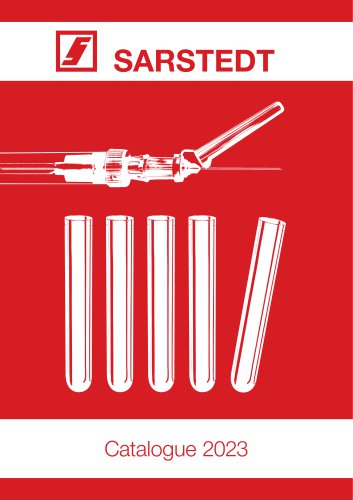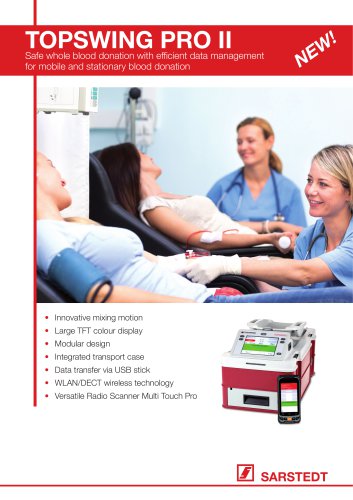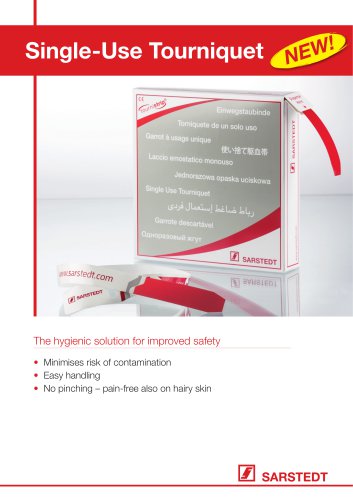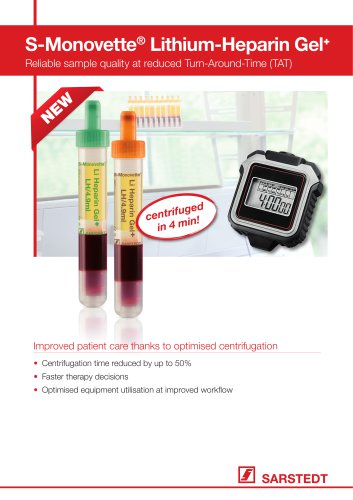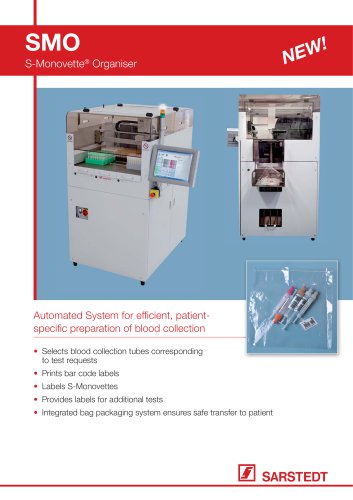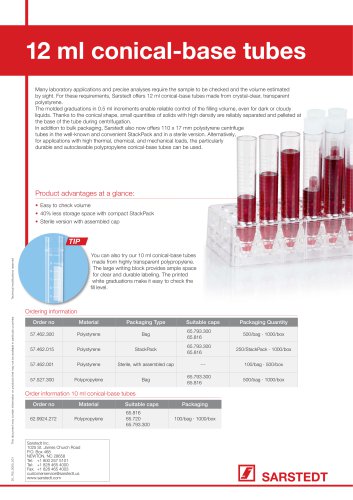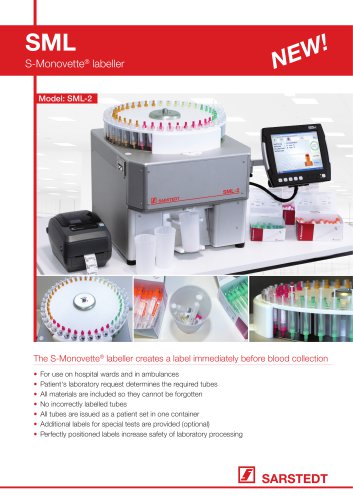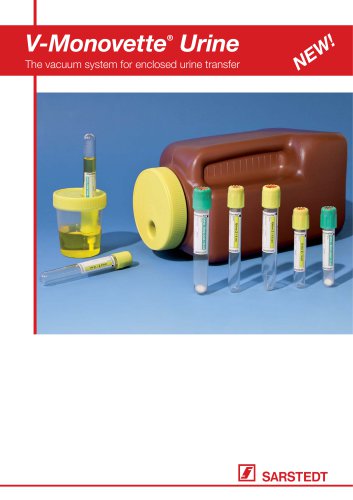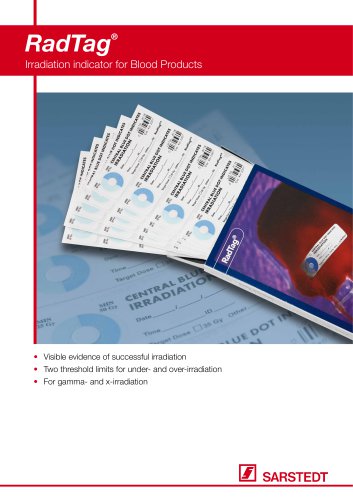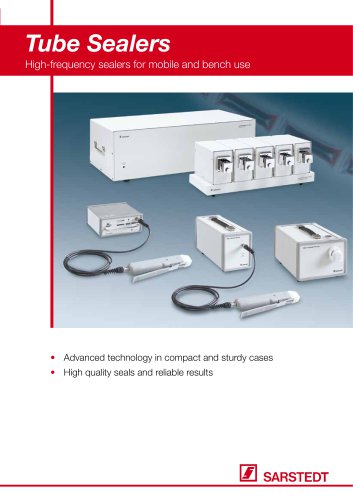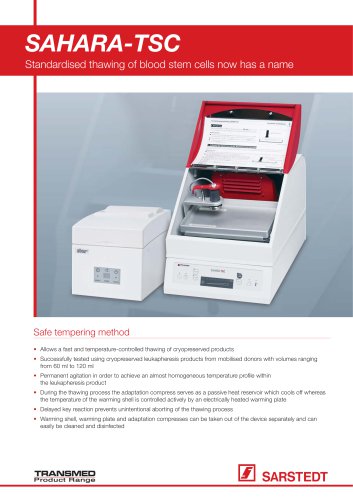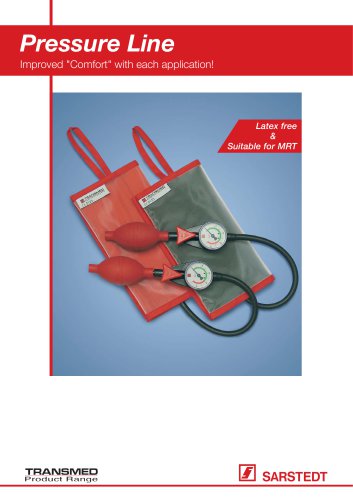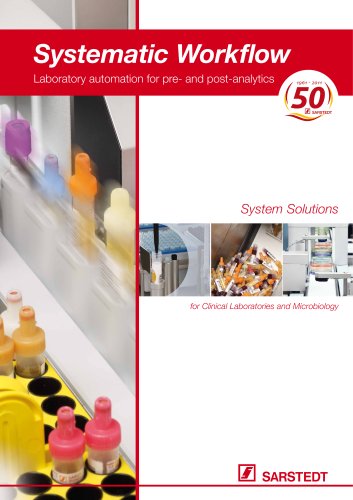
Catalog excerpts
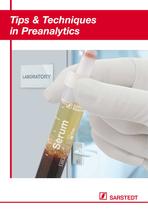
Tips & Techniques
Open the catalog to page 1
Optimal preanalytical work is a basic prerequisite for precise and conclusive laboratory diagnostics. Laboratory values can be correct only if and when all conditions prevailing at the time of blood collection are standardised. ”Tips & Techniques in Preanalytics“ is intended to support you in becoming familiar with, assessing and enhancing preanalytical influences. Please be aware that the topics addressed in ”Tips & Techniques in Preanalytics“ covering the fields of Venous Blood Collection, Capillary Blood Collection, and Urine Collection are recommendations only and do not, under any...
Open the catalog to page 2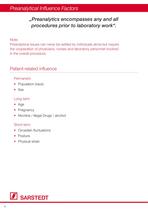
Preanalytical Influence Factors „Preanalytics encompasses any and all procedures prior to laboratory work“. Note: Preanalytical issues can never be settled by individuals alone but require the cooperation of physicians, nurses and laboratory personnel involved in the overall procedure. Patient-related influence Permanent • Population (race) • Sex Long-term • Age • Pregnancy • Nicotine / illegal Drugs / alcohol Short-term • Circadian fluctuations • Posture • Physical strain 4
Open the catalog to page 4
Permanent influence Population (race) There are significant differences between the black compared to the white population.. - Significantly lower leucocyte count - Vitamin B12 concentration is 1.35 times higher - Higher CK and α-amylases Sex Apart from individual sex-related co ponents (hormones), a person’s muscular m mass, for example, is one of the factors that determine pertinent parameters. - The proportion of CK and creatinine depends on the muscular mass. Long-term influence Age As a person grows older, the cholesterol level frequently increases in both men and women (although this...
Open the catalog to page 5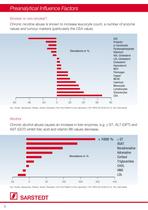
Preanalytical Influence Factors Smoker or non-smoker? Chronic nicotine abuse is known to increase leucocyte count, a number of enzyme values and tumour markers (particularly the CEA value). ACE Prolactin β-Carotinoids Pyridoxalphosphate Selenium HDL-Cholesterol LDL-Cholesterol Cholesterol Haematocrit MCV Fibrinogen Copper MCHC Cadmium Monocytes Lymphocytes Granulocytes CEA Deviations in % -60 -40 -20 0 20 40 60 80 Fig.: Guder, Narayanan, Wisser, Zawta ”Samples: From the Patient to the Laboratory“ GIT-VERLAG GmbH & Co. KG, Darmstadt Alcohol Chronic alcohol abuse causes an increase in liver...
Open the catalog to page 6
Short-term influence Increase in concentration when moving from the horizontal to an upright position. Physical strain Increase in various analytes after extreme physical strain, Uric acid Inorganic phosphate Alcaline phosphatase Increase in values x times the amount Fig.: Guder, Narayanan, Wisser, Zawta "Samples: From the Patient to the Laboratory" GIT-VERLAG GmbH & Co. KG, Darmstadt Effects of constriction time
Open the catalog to page 7
Preparation and Identification Patient preparation Informing the patient • Inform the patient of the forthcoming procedure in order to alleviate possible anxiety and stress. Explaining particular preconditions that must be observed is an essential part of this information, e.g. • Consumption of pharmaceutical drugs • Restriction to a special diet • Sample collection on an empty stomach (except for emergency diagnostics) Precise instructions for use should be given to explain the use of urine and faeces collection containers. Carefully explain the forthcoming procedures to children using...
Open the catalog to page 8
Sample identification • Never analyse sample tubes which are not clearly identified. • Barcode labels enable reliable sample identification. • The identification should always be provided on the primary tube. • Only use water-proof felt tip pens on glass or plastic tubes. • Additives (anticoagulants, clotting activators, gel) are identified by a colour code on the sample tubes. Due to the absence of international standardisation, additional identification may be required from case to case. Never provide sample identification on the cap, outer packaging or transport container. Barcode line...
Open the catalog to page 9
Preparation and Identification Phlebotomist identification The identity of the phlebotomist should be ascertainable for each sample taken and, • if possible, also noted on the request form Questions concerning the type and time of blood collection as well as problems, if any, during sampling, the patient‘s condition and other important issues might be helpful in the event of unclear analysis results. Ordering doctor’s identification The identity of the ordering doctor enables further enquiries in case of • illegible requests (e.g. certificates of referral) • erroneous requests (e.g....
Open the catalog to page 10
Blood Collection How to apply a tourniquet SAR ST T ED Puncture site Attach the tourniquet a few inches above the puncture site. Procedure: • Disinfect the selected puncture site. • After 30 to 60 seconds, wipe off the disinfectant using a dry swab. • Attach the tourniquet a few inches above the puncture site. • The pulse must be perceptible (tourniquet pressure: 50 - 100 mm Hg) • Maximum constriction time: 1 min. Recovery of diagnostic samples • • • • • • • • • • • • Wear gloves Have you checked the vein conditions? Disinfect the puncture site Do not touch the puncture site again Release...
Open the catalog to page 11
Blood Collection Problems prior to / during blood collection: Poor vein conditions: • Select new puncture site • Apply thermo-pad or pre-heated cloth • Use Multifly® set for difficult veins Penetrating the vein: • Slightly withdraw the needle Interruption of blood flow during collection: • Needle position has been changed • Vein has collapsed Wrong handling during blood collection: • • • • ”Pumping“ the fist to enhance blood flow leads to a rise in K+ and Mg2+ due to increased muscle activity Extended constriction changes parameters, e.g. K+, γ-GT ”Bending“ the needle is not necessary when...
Open the catalog to page 12All Sarstedt catalogs and technical brochures
-
Catalogue 2023
338 Pages
-
lumox® multiwell
2 Pages
-
GS 312
2 Pages
-
SARMIX® GM1
2 Pages
-
TRANS Control Transport box
2 Pages
-
Multi-Safe vario 2000
4 Pages
-
Medicine Cup
2 Pages
-
Incubator & Agitator
3 Pages
-
MegaBlock®
2 Pages
-
Urine Analysis
16 Pages
-
Urine Measuring System A06 W
4 Pages
-
TOPSWING
4 Pages
-
Blood Gas Analytics
3 Pages
-
Tube with saline solution
2 Pages
-
Lumox® x-well Technology
5 Pages
-
Gas Sampler
7 Pages
-
Transfusion devices
2 Pages
-
SAHARA-TSC
3 Pages
-
TRANSWAAG Pro
4 Pages
-
Single-Use Tourniquet
2 Pages
-
Microvette® APT
8 Pages
-
S-Monovette® POC Collect Kit
3 Pages
-
Systematic Workflow
17 Pages
-
HCTS 2000 MK2
3 Pages
-
PBM
3 Pages
-
Screw Cap Micro Tubes
16 Pages
-
REGANESTH® unoplex
2 Pages
-
Micro Tubes
16 Pages
-
Tourniquet application
3 Pages
-
Freezing tubes
3 Pages
-
IVARO Tube Handler
9 Pages
-
IsoFreeze® Rack
1 Pages
-
PCR & Molecular biology
21 Pages
-
White Multiply®-µStrips
2 Pages
-
Low Profile PCR items
1 Pages
-
NGS Library Preparation
2 Pages
-
Growth Surface References
20 Pages
-
Growth surfaces for cells
3 Pages
-
Automatic-Sarpette®
2 Pages
-
Micro-Needle
2 Pages
-
Blood Collection Systems
19 Pages
-
SMO S-Monovette® Organiser
2 Pages
-
12 ml Tube with conical base
1 Pages
-
S-Monovette® Hirudin 1.6 ml
2 Pages
-
SML-2 S-Monovette® Labeler
2 Pages
-
SML-3 S-Monovette® Labeler
2 Pages
-
IsoFreeze® PCR-Racks
1 Pages
-
Conversion of box packaging
2 Pages
-
PBM PatientBloodManagement
4 Pages
-
CATALOGUE GÉNÉRAL
109 Pages
-
THE SARSTEDT GROUP
9 Pages
-
White Multiply
2 Pages
-
REGANESTH
2 Pages
-
BL 1200
2 Pages
-
SML
2 Pages
-
V-Monovette urine
2 Pages
-
RadTag
2 Pages
-
Tube Sealers
4 Pages
-
Catheter quiver/Tube Holder
2 Pages
-
Transfusion systems
3 Pages
-
SAHARA-TSC
4 Pages
-
HAEM-o-TRANS
3 Pages
-
Pressure Line
4 Pages
-
SAHARA-III
4 Pages
-
ELISA Plates
3 Pages
-
HCTS2000 MK2
3 Pages
-
SMC 6 and SMC 6 plus
3 Pages
-
Single use tourniquets
2 Pages
-
Minivette® POCT
2 Pages
-
Sediplus
6 Pages
-
Celebration catalogue
220 Pages
-
Neutral Pipette Tips
1 Pages
-
2011 Systematic Workflow
32 Pages
-
Microbiology
12 Pages
-
flexiPERM®/quadriPERM®
2 Pages
-
miniPERM®
4 Pages
-
Cell and Tissue Culture
20 Pages
-
Sample Handling
4 Pages
-
Micro Tubes
4 Pages
-
Liquid Handling
40 Pages
-
Screw Cap Micro Tubes
8 Pages
-
Multi-Safe Disposal Box
16 Pages
-
S-Monovette® GlucoEXACT
40 Pages
-
Multi-Safe Disposal Box
12 Pages
-
Multiply® PCR Plates
7 Pages
-
UriSet 24
1 Pages
-
Urine Containers
1 Pages
-
Sediplus® S 100
1 Pages
-
S-Sedivette®
1 Pages
Archived catalogs
-
Forensic Swab
220 Pages


